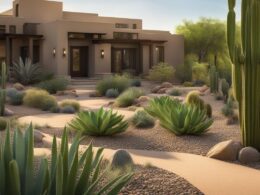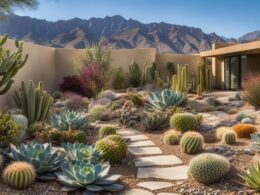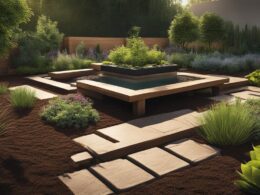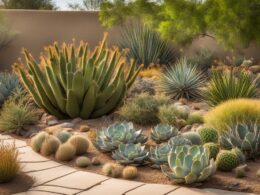Are you looking to create a vibrant and sustainable landscape that remains lush and green throughout the year? Look no further! In this guide, we will introduce you to the world of evergreen drought-resistant plants. These resilient plants not only reduce water usage but also provide year-round greenery for your garden.
With the increasing concern for water conservation and the need for low-maintenance landscaping, evergreen drought-resistant plants are gaining popularity. They are a perfect choice for homeowners who want to maintain a beautiful garden while minimizing water usage.
Key Takeaways:
- Evergreen drought-resistant plants offer year-round greenery while reducing water consumption.
- These plants are low-maintenance and require less watering compared to traditional garden plants.
- They provide visual interest and can serve as natural barriers or groundcovers.
- By incorporating evergreen drought-resistant plants into your landscape, you can create a sustainable and eco-friendly garden.
- Choose from a variety of evergreen groundcovers, shrubs, and hedges to suit your gardening needs.
The Benefits of Evergreen Groundcover Plants
When it comes to landscaping, evergreen groundcover plants offer a multitude of benefits. Not only do they provide visual interest throughout the year, but they also serve as habitat for overwintering insects and pollinators. One of the key advantages of evergreen groundcovers is their ability to prevent soil erosion. With their fibrous roots, these plants hold the soil in place, protecting it from being washed away during heavy rains or snowfall.
Another advantage of evergreen groundcover plants is their role in weed suppression. By shading the soil and limiting weed seed germination, they help to keep unwanted plants at bay. This not only reduces the need for manual weeding but also ensures that your garden remains neat and tidy. Additionally, many varieties of evergreen groundcovers produce colorful blooms during the growing season, adding a burst of color to your landscape and attracting pollinators to your garden.
Key Benefits:
- Visual interest throughout the year
- Habitat for overwintering insects and pollinators
- Prevention of soil erosion
- Weed suppression
- Colorful blooms that attract pollinators
Evergreen groundcover plants not only provide year-round greenery but also offer numerous benefits to your garden. From their visual appeal to their role in preventing soil erosion and attracting pollinators, these plants are a valuable addition to any landscape.
By incorporating evergreen groundcover plants into your garden, you can enjoy the benefits of reduced water use and the maintenance of lush greenery all year round. Whether you choose flowering varieties for added color or opt for low-growing options to cover bare ground, these hardy plants are a sustainable choice for any garden. So, why not explore the wide range of evergreen groundcover plants available and transform your landscape into a vibrant and ecologically friendly oasis?
Flowering Evergreen Groundcovers
If you’re looking to add a pop of color to your landscape while maintaining the benefits of evergreen groundcovers, consider incorporating flowering varieties. These plants not only provide year-round greenery, but also attract pollinators with their colorful blooms. Here are some popular options to consider:
Wall Germander
| Plant | Flower Color | Drought Tolerance |
|---|---|---|
| Wall Germander | Purple-pink | High |
| Flowering Thyme | Lavender | Moderate |
| Prickly Pear Cactus | Various | High |
| Lilyturf | Purple | Moderate |
| Sedums | Various | High |
Wall germander is a drought-tolerant option that produces purple-pink flower spires. It adds a vibrant touch to your landscape while withstanding dry conditions. Flowering thyme is another great choice, known for its cold tolerance and fragrant leaves. If you’re looking for something unique, consider prickly pear cactus. It offers open, colorful blooms and is a hardy groundcover option. Lilyturf and sedums are also excellent choices, providing beautiful purple blooms and requiring moderate to high drought tolerance.
By incorporating these flowering evergreen groundcovers into your landscape, you can enjoy the benefits of year-round greenery while adding a burst of color and attracting pollinators to your garden.
Evergreen Groundcover Plants for Sun
When it comes to selecting evergreen groundcover plants for sun-drenched areas, you have several options that are both beautiful and drought-tolerant. These sun-loving groundcovers not only provide year-round greenery but also help to reduce water usage in your garden. By choosing the right plants, you can create a sustainable and visually appealing landscape.
One popular choice for sunny areas is Bugleweed (Ajuga reptans), which features blue-purple flowers and can tolerate high heat and dry conditions. Its dense foliage forms a low, spreading mat that effectively covers bare ground. Another versatile option is Mini Mondo Grass (Ophiopogon japonicus), which is well-suited for planting between stepping stones or around the base of trees. Its dark green foliage adds an interesting texture to the landscape.
To create a thick, leafy mat, Wintercreeper (Euonymus fortunei) is an excellent choice. This fast-growing evergreen groundcover can withstand full sun and has attractive variegated foliage. Its ability to form a dense cover makes it ideal for erosion control on slopes. For a touch of drama, consider Black Mondo Grass (Ophiopogon planiscapus ‘Nigrescens’), which features deep purple-black foliage and a low-growing habit. It thrives in sunny locations and adds a unique visual element to any garden.
| Plant | Description | Light Requirements | Drought Tolerance |
|---|---|---|---|
| Bugleweed | Low-growing groundcover with blue-purple flowers | Full sun | High drought tolerance |
| Mini Mondo Grass | Versatile groundcover with dark green foliage | Full sun | Moderate drought tolerance |
| Wintercreeper | Fast-growing groundcover with variegated foliage | Full sun | High drought tolerance |
| Black Mondo Grass | Low-growing groundcover with deep purple-black foliage | Full sun | High drought tolerance |
By incorporating these evergreen groundcover plants into your sunny garden, you can enjoy the benefits of year-round greenery while reducing your water usage. Their ability to thrive in full sun and tolerate drought conditions makes them an excellent choice for creating a low-maintenance and sustainable landscape.
Evergreen Groundcover Varieties for Shade
When it comes to creating a lush and vibrant garden in shaded areas, choosing the right evergreen groundcover varieties is essential. These plants thrive in low-light conditions and provide year-round greenery. Not only do they add visual interest to your landscape, but they also help reduce water use and maintain a healthy ecosystem. Here are some shade-loving evergreen groundcover options that are drought-tolerant and perfect for shaded areas:
1. Bugleweed
Bugleweed is a versatile groundcover with various leaf colors, including shades of green, purple, and bronze. It forms a dense mat of foliage and produces spikes of blue or purple flowers in the spring. Bugleweed is known for its ability to withstand shade and is an excellent option for adding color and texture to your garden.
2. Ivy
Ivy is a classic choice for creating a dense and green groundcover in shaded areas. It has cascading vines with glossy leaves that add a touch of elegance to any landscape. Ivy is low-maintenance and can cover large expanses of ground with ease. It also provides shelter for small wildlife and attracts beneficial insects.
3. Lilyturf
Lilyturf is a popular shade-loving groundcover that forms clumps of arching, grass-like leaves. In the spring, it produces spikes of purple flowers that add a splash of color to shaded areas. Lilyturf is easy to grow and requires minimal maintenance, making it a great choice for busy gardeners.
4. Oregon Grape Holly
Oregon grape holly is a native evergreen shrub that thrives in shaded areas. It features glossy leaves and produces clusters of yellow flowers in the spring, followed by blue-black berries. Oregon grape holly is known for its drought tolerance and ability to attract pollinators. It provides year-round interest and adds a touch of elegance to any garden.
By incorporating these shade-loving evergreen groundcovers into your garden, you can create a lush and thriving landscape even in areas with limited sunlight. These plants not only add beauty and visual interest but also contribute to a sustainable and water-efficient garden. Choose the right evergreen groundcover varieties for shade and enjoy a vibrant garden all year round.
Arborvitae: A Reliable Evergreen Hedge
When it comes to creating a low-maintenance, evergreen hedge, arborvitae is a dependable choice. With its feathery foliage and adaptability to various growing conditions, this shrub is widely used for hedges and screening purposes. Whether you’re looking to define boundaries, create privacy, or add visual interest to your landscape, arborvitae delivers.
Arborvitae is known for its dense growth habit, making it an excellent choice for hedge planting. It forms a solid wall of greenery, providing a natural barrier and a sense of enclosure. The foliage maintains its lush green color throughout the year, ensuring that your hedge remains vibrant and appealing, even during the winter months.
This reliable evergreen hedge is also a low-maintenance option, requiring minimal care once established. Arborvitae is drought-tolerant and can withstand a range of soil conditions, from sandy to clay. Regular watering during the establishment period is crucial, but once the shrubs are well-established, they can handle periods of dry weather with ease.
The Benefits of Arborvitae as a Hedge:
- Privacy: Arborvitae forms a dense barrier, providing privacy from neighbors or screening undesirable views.
- Low Maintenance: Once established, arborvitae requires minimal pruning, making it a low-maintenance hedge option.
- Year-Round Greenery: The evergreen foliage ensures your hedge remains lush and attractive throughout the year.
- Adaptability: Arborvitae can tolerate a variety of growing conditions and is suitable for different climates.
- Drought Tolerance: Once established, arborvitae can withstand periods of dry weather without frequent watering.
Whether you’re looking to create a privacy screen, define garden boundaries, or enhance the aesthetic appeal of your landscape, arborvitae is a reliable choice for an evergreen hedge. Its dense growth, low-maintenance nature, and adaptability make it a popular shrub among gardeners. Enjoy the beauty and functionality of arborvitae in your outdoor space.
Blue Holly: Bright Colors and Winter Berries
The blue holly, also known as Ilex x meserveae, is a versatile evergreen shrub that adds vibrant colors to the landscape. It features glossy blue-green foliage that remains attractive throughout the year, making it a great choice for maintaining greenery in your garden. One of the standout features of the blue holly is its ability to produce bright red berries in the fall and winter months. These berries not only add a pop of color to your garden during the colder seasons but also provide a valuable food source for birds and other wildlife.
The blue holly is not only visually appealing but also serves as a pollinator-friendly plant. Its bright-colored foliage and berries attract bees, butterflies, and other pollinators, helping to support the local ecosystem. By incorporating blue holly into your garden, you can create a welcoming habitat for beneficial insects and contribute to pollinator conservation efforts.
“The blue holly’s colorful foliage and red berries provide a stunning display of color and texture in any garden. It is a versatile plant that can be used as a focal point, hedge, or even in container gardening. Its pollinator-friendly nature makes it an excellent choice for eco-conscious gardeners.”
Blue Holly Varieties
There are several varieties of blue holly to choose from, each offering unique characteristics and growth habits. Here are a few popular options:
- Meserveae Blue Princess: A compact variety with glossy blue-green leaves and abundant red berries.
- Meserveae Blue Maid: Similar to Blue Princess, but with a more upright growth habit and larger berries.
- Blue Stallion: A male pollinator variety with attractive blue foliage and no berries. It pairs well with female blue holly varieties to ensure berry production.
When selecting blue holly for your garden, consider the specific growth requirements of each variety and choose the one that best suits your landscape design and maintenance preferences.
| Variety | Foliage Color | Berry Production | Growth Habit |
|---|---|---|---|
| Meserveae Blue Princess | Glossy blue-green | Abundant red berries | Compact |
| Meserveae Blue Maid | Glossy blue-green | Large red berries | Upright |
| Blue Stallion | Blue | No berries | Moderate |
Table: Blue Holly Varieties and Their Characteristics
Boxwood: A Classic Evergreen Hedge
Boxwood is a timeless choice for creating formal and elegant hedges with its classic appeal and versatility. This low-maintenance shrub is known for its ability to maintain formal shapes and provide year-round greenery. Its small, dense leaves and compact growth habit make it an ideal plant for trimming into geometric shapes or sculpted designs.
One of the main advantages of boxwood as a hedge plant is its ability to withstand frequent pruning and shaping without losing its elegant appearance. It can be easily trained into various forms, such as low borders, topiary shapes, or even privacy screens. Boxwood’s dense foliage also provides excellent coverage, making it an effective tool for creating a sense of enclosure and separation in your garden or landscape.
Aside from its aesthetic qualities, boxwood is a great choice for those seeking a low-maintenance shrub. It is relatively drought-tolerant once established and requires minimal watering once its root system has developed. Additionally, boxwood is generally resistant to many common pests and diseases, which means less time spent on pest control and treatment.
In summary, boxwood is a classic hedge plant that offers formal shapes, low-maintenance care, and a touch of timeless elegance to any garden or landscape. Whether you’re looking to create a traditional formal hedge or sculpted topiary, boxwood provides the versatility and durability needed to achieve your desired design.
Camellia: Winter Blooms and Fragrance
When it comes to adding beauty and fragrance to your winter landscape, camellias are an excellent choice. These evergreen flowering shrubs are known for their stunning blooms, which come in a variety of colors including white, red, pink, and bicolors. With their vibrant colors and delightful fragrance, camellias are sure to bring life to your garden during the colder months.
One of the remarkable features of camellias is their ability to bloom in winter or early spring when many other plants are dormant. This makes them a valuable addition to your landscape, providing bursts of color and joy during the otherwise dreary season. Whether you choose a single camellia bush or a diverse mix of colors and varieties, these flowering shrubs are sure to make a statement in your garden.
Camellias are evergreen, meaning they retain their leaves year-round. This not only adds visual interest but also provides a lush backdrop for the vibrant blooms. The glossy leaves of camellias create a beautiful contrast against the colorful flowers, enhancing the overall appeal of these stunning shrubs. Their dense foliage also provides privacy and serves as a natural screen, making camellias a versatile choice for any garden.
Whether you’re looking to add winter color, fragrance, or evergreen beauty to your garden, camellias are a perfect choice. With their stunning blooms, delightful fragrance, and year-round greenery, these evergreen flowering shrubs will bring life and joy to your landscape throughout the winter months.
Juniper: Prickly Foliage and Versatility
Juniper is a versatile evergreen shrub that offers a range of benefits for your landscape. With its prickly foliage and unique characteristics, juniper can be used in various ways to enhance your outdoor space. Whether you’re looking for a low-growing groundcover or a more upright shrub, juniper has the versatility to meet your needs.
One of the key advantages of juniper is its low-growing varieties that work well as evergreen groundcovers. These low-growing junipers create a carpet-like effect, spreading across the ground and providing a lush green cover. They are excellent for filling in gaps between larger plants, preventing soil erosion, and adding visual interest to your garden.
Additionally, juniper’s prickly foliage acts as a natural deterrent, making it ideal for planting along property boundaries or in areas where you want added security. The thorny branches can help prevent unwanted intrusions and provide a barrier that adds privacy to your outdoor space.
Furthermore, juniper is known for its hardiness and ability to thrive in various growing conditions. It can tolerate drought, heat, and poor soil, making it a resilient choice for your garden. Juniper also requires minimal maintenance, making it a hassle-free option for busy gardeners. With its striking appearance and adaptability, juniper is a reliable choice for adding texture, color, and versatility to your landscape.
Benefits of Juniper:
- Versatile evergreen shrub
- Low-growing varieties for groundcover
- Prickly foliage for added security
- Hardy and adaptable to various growing conditions
- Requires minimal maintenance
Table: Varieties of Juniper
| Variety | Description | Height | Spread | Best Uses |
|---|---|---|---|---|
| Blue Rug Juniper | Low-growing, spreading variety with blue-green foliage | 6-12 inches | 4-6 feet | Groundcover, erosion control |
| Wichita Blue Juniper | Upright, conical shape with silver-blue foliage | 10-15 feet | 6-8 feet | Accent plant, specimen shrub |
| Hetz Columnar Juniper | Narrow, columnar form with dense, green foliage | 10-15 feet | 2-3 feet | Screens, hedges |
| Skyrocket Juniper | Pyramidal shape with silvery-blue foliage | 10-15 feet | 2-3 feet | Vertical accent, privacy hedge |
Juni… what? If you’re not familiar with juniper shrubs, you’re missing out on a versatile, low-maintenance plant that can bring both texture and color to your landscape. Juniper’s prickly foliage acts as a natural deterrent, making it ideal for planting along property boundaries or in areas where you want added security. With its hardiness and adaptability, juniper is a reliable choice for adding beauty and functionality to your outdoor space.
Dwarf Blue Spruce: Striking Color and Form
If you’re looking to add a touch of striking color and unique form to your landscape, consider incorporating the Dwarf Blue Spruce. Known for its blue-gray needles and compact size, this small conifer is a perfect addition to gardens of all sizes. With its year-round color, the Dwarf Blue Spruce is sure to be a standout feature in your outdoor space.
The blue-gray needles of the Dwarf Blue Spruce create a stunning visual contrast against traditional green foliage. Whether planted as a focal point or used as a border, this evergreen shrub adds a touch of elegance and sophistication to any garden. The compact size of the Dwarf Blue Spruce also makes it a versatile choice, ideal for both small spaces and mixed shrub borders.
“The blue-gray needles of the Dwarf Blue Spruce create a stunning visual contrast against traditional green foliage.”
In addition to its striking color, the Dwarf Blue Spruce is a low-maintenance plant that requires minimal care. It is drought-tolerant, meaning it can thrive in various weather conditions and requires less water compared to other plants. With its hardy nature, the Dwarf Blue Spruce is well-suited for gardens in regions with fluctuating climates.
Key Features of the Dwarf Blue Spruce:
- Blue-gray needles that provide year-round color
- Compact size, suitable for small spaces
- Drought-tolerant and low-maintenance
- Striking visual contrast against green foliage
With its unique color and form, the Dwarf Blue Spruce is an excellent choice for adding visual interest to your landscape. Whether used as a focal point or part of a larger design, this small conifer is sure to enhance the beauty of your outdoor space throughout the year.
| Key Features | Description |
|---|---|
| Needle Color | Blue-gray |
| Size | Compact |
| Tolerance | Drought-tolerant |
| Visual Appeal | Striking contrast |
Overall, the Dwarf Blue Spruce is a fantastic choice for adding year-round color, texture, and form to your garden. Its blue-gray needles, compact size, and low-maintenance nature make it a wonderful addition to any landscape. Whether planted as a standalone specimen or incorporated into a larger design, the Dwarf Blue Spruce is sure to bring beauty and visual interest to your outdoor space.
Conclusion
In conclusion, incorporating evergreen drought-resistant plants into your landscape can provide year-round greenery and help reduce water use. These plants are not only visually appealing but also offer a range of benefits. They add visual interest to your garden, provide habitat for pollinators, control erosion, and suppress weeds.
By choosing these hardy plants, you can maintain lush greenery throughout the year, even in dry conditions. Whether you opt for flowering evergreen groundcovers, sun or shade-loving shrubs, or classic hedge plants, there is a wide variety of options available to suit your preferences and garden needs.
Not only will these plants enhance the aesthetic appeal of your landscape, but they also contribute to a sustainable approach to gardening. Their ability to withstand drought conditions and reduce water usage makes them an excellent choice for eco-conscious gardeners. So, go ahead and create a beautiful and sustainable garden with evergreen drought-resistant plants that will keep your outdoor space green and vibrant all year round.
FAQ
What are evergreen groundcover plants?
Evergreen groundcover plants are low-growing plants that provide multiple purposes in the landscape, such as limiting weed growth and soil erosion. They have fibrous roots that help prevent soil erosion and act as a living mulch, shading the soil and limiting weed seed germination.
What benefits do evergreen groundcover plants offer?
Evergreen groundcover plants provide visual interest throughout the year, shelter overwintering beneficial insects and pollinators, have fibrous roots that prevent soil erosion, and help diffuse heavy rain and snowfall. They also act as a living mulch, shading the soil and limiting weed seed germination.
Do flowering evergreen groundcovers exist?
Yes, there are flowering evergreen groundcovers. Some popular options include Wall germander, flowering thyme, prickly pear cactus, lilyturf, sedums, candytuft, and creeping phlox.
Can I find evergreen groundcover plants for sunny areas?
Absolutely! Bugleweed, mini mondo grass, wintercreeper, and black mondo grass are great choices for sunny areas. They tolerate high heat and dry conditions and form dense, low-growing mats.
Are there evergreen groundcover varieties for shaded areas?
Yes, there are several evergreen groundcover varieties that thrive in low-light conditions. Bugleweed, ivy, lilyturf, and Oregon grape holly are excellent choices for shaded areas.
What is arborvitae and why is it a reliable evergreen hedge?
Arborvitae is a versatile evergreen shrub that features feathery foliage and can withstand a variety of growing conditions. It is commonly used as a hedge or screening plant and comes in different sizes to suit different needs.
What is blue holly and why is it a popular choice?
Blue holly, also known as Ilex x meserveae, is an evergreen shrub that adds vibrant colors to the landscape. It has glossy blue-green foliage and produces bright red berries in the fall and winter months. Blue holly is loved by pollinators and adds winter interest to the garden.
What is boxwood and why is it considered a classic evergreen hedge?
Boxwood is a classic evergreen shrub that is often used for creating formal hedges and sculpted shapes. It has small, dense leaves and can withstand pruning well. Boxwood adds a strong visual presence to any landscape and is considered a low-maintenance shrub.
What is camellia and why is it a popular choice among gardeners?
Camellia is an evergreen shrub that is beloved for its winter or early spring flowers. It comes in a range of colors, including white, red, pink, and bicolors. Camellias add beauty and fragrance to the landscape, making them a popular choice among gardeners.
What is juniper and why is it considered a versatile evergreen shrub?
Juniper is a versatile evergreen shrub with prickly foliage. There are low-growing varieties that work well as evergreen groundcovers and others that have a more upright habit. Junipers tolerate a variety of challenging conditions and are easy to maintain.
What is dwarf blue spruce and why is it popular in landscapes?
Dwarf blue spruce is a slow-growing evergreen shrub that stands out in any landscape with its striking blue-gray needles. It adds year-round color and interest to the garden and works well in small spaces or mixed shrub borders.














